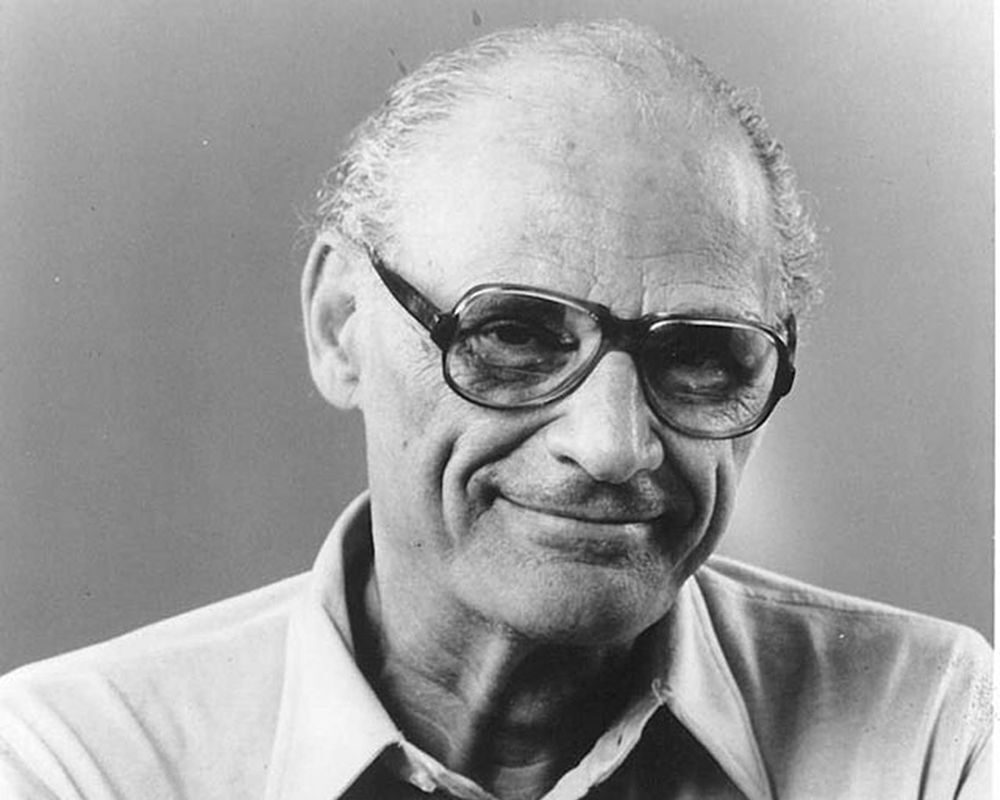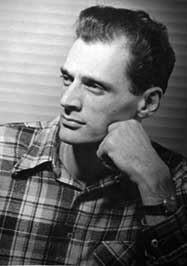Playwright Arthur Miller, ’38, is perhaps best known as the artist who transformed American theater with such groundbreaking works as Death of a Salesman (1949) and The Crucible (1953), among others.
Miller is decidedly less known for his work as a magazine writer. But among his clips, one will find a lengthy essay he penned for the December 1953 issue of Holiday magazine titled simply “University of Michigan by Arthur Miller.” The piece details the writer’s enduring affection for his alma mater, despite some significant changes that transformed his beloved campus in the 15 years since he’d left.
Philadelphia-based Holiday, which published from 1946-77, was noted for printing the work of some of the most iconic writers of the time, thanks to editor Ted Patrick. He would promote Miller’s provocative piece as one in which “a famous playwright revisits the scenes of his college days and brings back an affectionate, soul-searching, and controversial essay on the life and times of a great university.”
Six decades may have passed since its initial publication, but the piece is rich with timeless sentiments that still resonate today.
Eyes on the Prize
Miller opens the essay by letting readers know that “my first affection for the University of Michigan was due, simply, to their accepting me. They had already turned me down twice because of my academic record. It was so low as to be practically invisible, but the dean reversed himself after two letters in which I wrote that since working for two years in a warehouse at $15 a week, I had turned into a much more serious fellow. He said he would give me a try, but I had better make some grades. I could not conceive of a dean at Columbia or Harvard doing that.”
Miller, born and raised in New York City, was the son of a successful coat manufacturer who had been chauffeured to work each day prior to the Great Depression. The post-crash downturn in the family fortune saw the Millers relocating from Manhattan to Brooklyn. At 16, Miller earned a wage delivering bread on his bicycle while dreaming of his future as a playwright. He had flunked high school algebra three times, but still set his sights on college, specifically Michigan, which was the exclusive home to the Avery Hopwood Award. Winning such an accolade would bring both critical prestige—and critical funding—to finance his creative habit.
The bar to admission was admittedly high for Miller. Beyond his low grades in math, he would have to, as an out-of-state student, prove he wouldn’t “go on relief.” Admitted students were required to have at least $500 in savings, let alone prove it by showing one’s banking passbook. Miller took a job in an auto parts warehouse, and saved enough of his own money in two years to exceed the admissions requirements.
Shelter from the storm
Traveling to Michigan, passbook in hand, Miller was ready to embark on his first adult adventure. He tells the readers of Holiday: “When I arrived in 1934, at the bottom of the Depression, I fell in love with the place, groggy as I was from the bus ride, because I was out of the warehouse and at least formally a part of a beautiful town, the college town of Ann Arbor.”
At the time Miller entered college, America’s economy was as depleted as its topsoil. Unemployment soared in the cities, while drought, high winds, and overuse of farmland ravaged the rural landscape. University life promised Miller brief respite from such harsh realities, but still offered a compelling microcosm of the larger world.
“When I was in Ann Arbor, I felt I was at home,” he writes. “My friends were the sons of die-makers, farmers, ranchers, bankers, lawyers, doctors, clothing workers, and unemployed relief recipients. They came from every part of the country and brought all their prejudices and special wisdoms.”
Like most college freshmen, Miller was fascinated by the friends he made. “I loved it because of the surprises,” he writes. “Elmo Hamm, the son of a potato farmer in Upper Michigan, turned out to be as sharp as any of the myopic drudges who got the best grades in New York. I loved it because Harmon Rammel, the son of an Arkansas banker, lived in the room next to mine and from him I got a first glimpse what the South meant to a Southerner, a Southerner who kept five rifles racked on the wall, and two .38s in his valise, and poured himself bullets in a little mold he kept on his desk.”
Life lessons abounded as Miller grew into his studies and his social life: “I learned that toward June you could swim in a certain place without a suit on, and that the Arboretum … was also good for anatomical studies, especially in spring under a moon. I had come to school believing that professors were objective repositories of factual knowledge; I found that they were not only fallible but some of them were damn fools, and enough of them seekers and questioners to make talking with them a long-lasting memory.”
A playwright is born
Soon Miller discovered Michigan was, as he had imagined, an ideal place for a talented writer to hone his craft. It was just big enough “to give one the feeling that his relative excellence or mediocrity had real meaning and yet not so big as to drown one in numbers.”
To make ends meet, the young student traded meals for washing dishes in a co-op. He earned walkaround money by feeding research mice under the National Youth Administration work-study New Deal program. He paid $1.75 a week for his room at 411 N. State St.—he called it the Doll’s House—where, under the tutelage of Professor Kenneth Rowe, he wrote his first play.
“I remember the June of each year when the Hopwood Awards were announced, and the crowds would form to hear the featured speaker,” he writes. “I have never sweated on an opening night the way I did at Hopwood time.”
Miller would win two Hopwood Awards—sharing the first, winning the second outright. Upon graduating and leaving campus in 1938, he returned to New York to write, his talent further developing, his plays being produced on Broadway.
The times they are a-changin’
When he revisited Ann Arbor for the 1953 Holiday assignment, Miller observed how progress had transformed his beloved campus. “There are buildings now where I remembered lawns and trees,” he writes. He was disillusioned by the “Detroit Modern” architecture, fluorescent lighting, and cold, steel furniture that had moved in since he’d left. “There’s a certain propriety around the place that I found quite strange. Or was it always that way and I didn’t notice?” he wonders.
The Michigan of his time had been “full of speeches, meetings, and leaflets. It was jumping with Issues.” But on first interaction with students in 1953, Miller sensed a different energy. A postwar obsession with competition seemed, to him, to have killed the creative iconoclast and free thinker at U-M. Older now, he sensed “the University has a feel of a professional workshop these days,” with a goal-oriented emphasis on achievement, where everything is defined. “The place is full of comportment,” he laments. “Maybe I have been around theatrical folk too long but it seemed to me that everybody had turned into engineers.”
This was the height of McCarthyism, and during a visit to his former employer, The Michigan Daily, Miller learned that every week a state trooper came into the student paper’s office and read the published letters to see if there were any “radicals” that merited investigation. The fact that no one seemed to mind was particularly abhorrent to him, and he could not shake the unsettling feeling that the University was in danger of succumbing to “a profound shift of values which will make of Michigan a place not unintelligent, not overtly browbeaten, but a school of obedient pragmatists where each individual walks in blinders toward his niche in government or giant corporation, his soul unswept by the hot blasts of new ideas and vast social concepts.”
Everlasting love
On continued observation, Miller was relieved to witness reassuring evidence of intellectual vigor, critical thinking, and social conscience. He sat in on a graduate seminar in political science and was heartened by a level of maturity in Michigan students that he admitted was superior to that of his peers. “It is a long time since I witnessed such complete concentration upon essentials, sharpness of mind, and freedom from cant and sloganeering,” he writes. “They know now that the old easy solutions are suspect, and they are examining rather than exhorting each other.”
And despite an obvious generation gap that all alumni surely feel upon returning to their alma mater after 15 years, Miller still felt a deep connection to the Class of 1953: “They spoke like seekers as avid for the truth as I suppose we were so long ago. I know that they do not think of themselves as the silent generation, or as a generation at all but simply as ‘me.'”
He wraps the essay while waiting for a flight from Willow Run Airport and reflects on how different this exit from campus would be from the first time he left as a young graduate in 1938. Back then, he’d accepted a ride from a salesman passing through Ann Arbor en route to New York.
“I tried to tell him what Michigan really was,” Miller recalls in his conclusion. “It was the professor who, with selected members of his class, held séances during which the spirits of Erasmus, Luther, and other historical figures were summoned and listened to. It was the fraternity boys sitting on the porches of their mansions, singing nostalgic Michigan songs as in a movie, and it was three radicals being expelled. It was, in short, the testing ground for all my prejudices, my beliefs, and my ignorance, and it helped to lay out the boundaries of my life. For me it had, above everything else, variety and freedom. It is probably the same today. If it is not, a tragedy is in the making.”





Sally Chambers - December 1966
I remember reading Arthur Miller’s essay “The University of Michigan” in an anthology assigned in my freshman English class in 1963. It captured many of my first impressions of the university, Ann Arbor and the excitement of starting a new life. Reminiscing about my years at U of M, I recalled that essay and was delighted to read your article highlighting it. Do you know where I might find a copy of the original essay? Thanks.
Reply
Deborah Holdship
Hi, Sally: I have a photocopy of that article I’d be happy to send you. Email me at holdship@umich.edu and we’ll work out the details. Glad you liked this story! Deborah
Reply